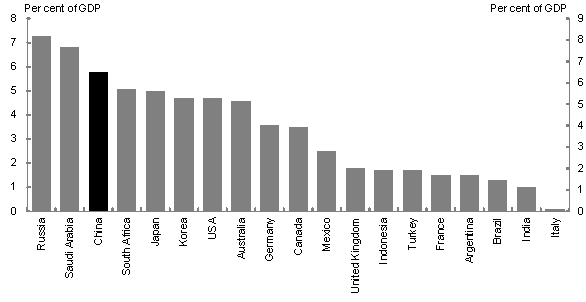The global financial crisis came at a time when China's economy had been growing strongly and the Central Government had been seeking to moderate activity to contain inflationary pressures. Fiscal policy settings were prudent, with a modest fiscal deficit and relatively low levels of Central Government debt. Credit conditions had been tightened through lending targets, higher RRRs, and higher interest rates. With the banks constrained in their lending, there was the potential to release a significant amount of cash reserves into the system. China was therefore well placed to switch the levers to stimulus mode when global conditions deteriorated.
The RMB 4 trillion stimulus package was announced in November 2008. The amount of new spending was somewhat below this figure, making it difficult to determine the actual level of the ‘stimulus' in China's stimulus package. For example, the figure includes infrastructure projects that would have proceeded in any case, most notably the RMB 1 trillion Sichuan earthquake reconstruction. The IMF estimated that the total size of new stimulatory measures was about RMB 2 trillion, equating to 3.1 per cent of GDP in 2009 and 2.7 per cent in 2010. On these IMF estimates, China's stimulus was the third largest package implemented by any country (see Chart 4).
Chart 4: Combined 2009 and 2010 stimulus, by country

Source: IMF 2010.
The package was predominantly investment-focussed, in contrast to the packages announced in many advanced economies, which had significant upfront consumption elements. In Western countries, the first response was to put money into the pockets of consumers to get stimulus spending into the economy quickly. In many cases, investment spending came later, given implementation lags. In China's centrally planned, investment-orientated economy, investment was seen as the most direct and effective method of stimulating activity. Consumption-based measures played a relatively minor role in China's stimulus package, although there were some tax-related policy measures implemented and direct consumption subsidies introduced.
Table 1: Breakdown of the RMB 4 trillion stimulus package (RMB)
| Infrastructure | 2.87 |
| General Infrastructure | 1.50 |
| Reconstruction of Sichuan earthquake area | 1.00 |
| Rural area infrastructure | 0.37 |
| Technology & Environment | 0.58 |
| Technology & structural adjustment | 0.37 |
| Energy savings & emission reductions | 0.21 |
| Social Measures | 0.55 |
| Construction & renovation cheap houses | 0.40 |
| Social security & health | 0.15 |
Source: NDRC 2009.
Infrastructure made up the majority (72 per cent) of the stimulus package (see Table 1). The main components of the infrastructure section are the RMB 1 trillion of re-construction of the Sichuan earthquake area, and an estimated RMB 1 trillion spent on developing high-speed railways. Most of the spending occurred through local governments, which were able to quickly mobilise activity on infrastructure projects.
This spending was financed in part through the Central Government budget. The budget deficit was expanded from around ¾ per cent in 2008 to 2¾ per cent in 2009, before narrowing to 1¾ per cent in 2010. This was a relatively modest turnaround in the budget position given the size of the package. The USA, which introduced a smaller package (as a share of its economy), had a turnaround of nearly 7 per cent of GDP in its budget balance (Congressional Budget Office, 2011). In China, most of the spending was financed through the expansion of credit.
The Central Government directly funded around 30 per cent of the stimulus package. The remainder of the fiscal stimulus was funded through borrowing by local governments. While local governments are prevented by Central Government legislation from borrowing directly, they were able to set up local government financing vehicles (LGFVs). LGFVs are local government-owned entities that are typically provided with land as an asset. Using the land as collateral, LGFVs obtain loans from banks to finance infrastructure projects. This mechanism is estimated to have funded the majority of the RMB 2.8 trillion local government part of the stimulus package.
With around two-thirds of the stimulus package funded through borrowing, expansion of credit was a critical element of the stimulus package. The most important means of expanding credit was the increase in new lending targets, from RMB 4.7 trillion in 2008 to RMB 10 trillion in 2009 (the actual amount of loans totalled RMB 9.6 trillion in 2009). RRRs were also significantly lowered, from 17.5 per cent to 13.5 per cent for smaller banks and 15.5 per cent for larger banks. The lending interest rate was reduced from 7.47 per cent to 5.31 per cent. The deposit rate was reduced from 4.14 per cent to 2.25 per cent.
The stimulus strategy revolved around turning on the credit tap to access the large amounts of cash reserves sitting within the banking system. Providing local governments a means of accessing this credit allowed the stimulus to be directed towards infrastructure projects considered worthwhile by the Central Government. It allowed the Central Government to do this in a way that did not blow out the headline budget deficit (which stayed within the Ministry of Finance's 3 per cent target), and reduced the need to physically transfer funds to the various other layers of government. The monetary and fiscal elements of the package were therefore well integrated and crafted to meet a range of policy objectives.